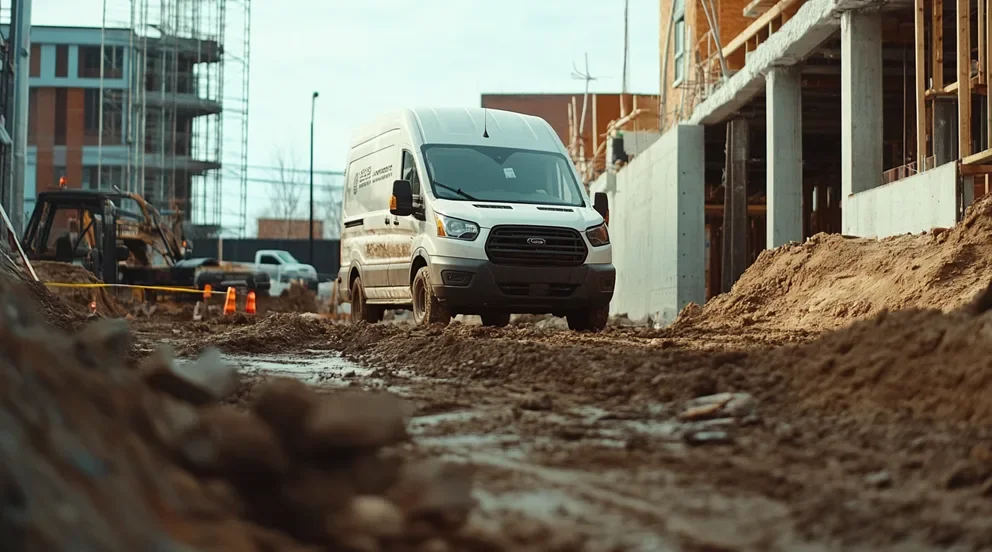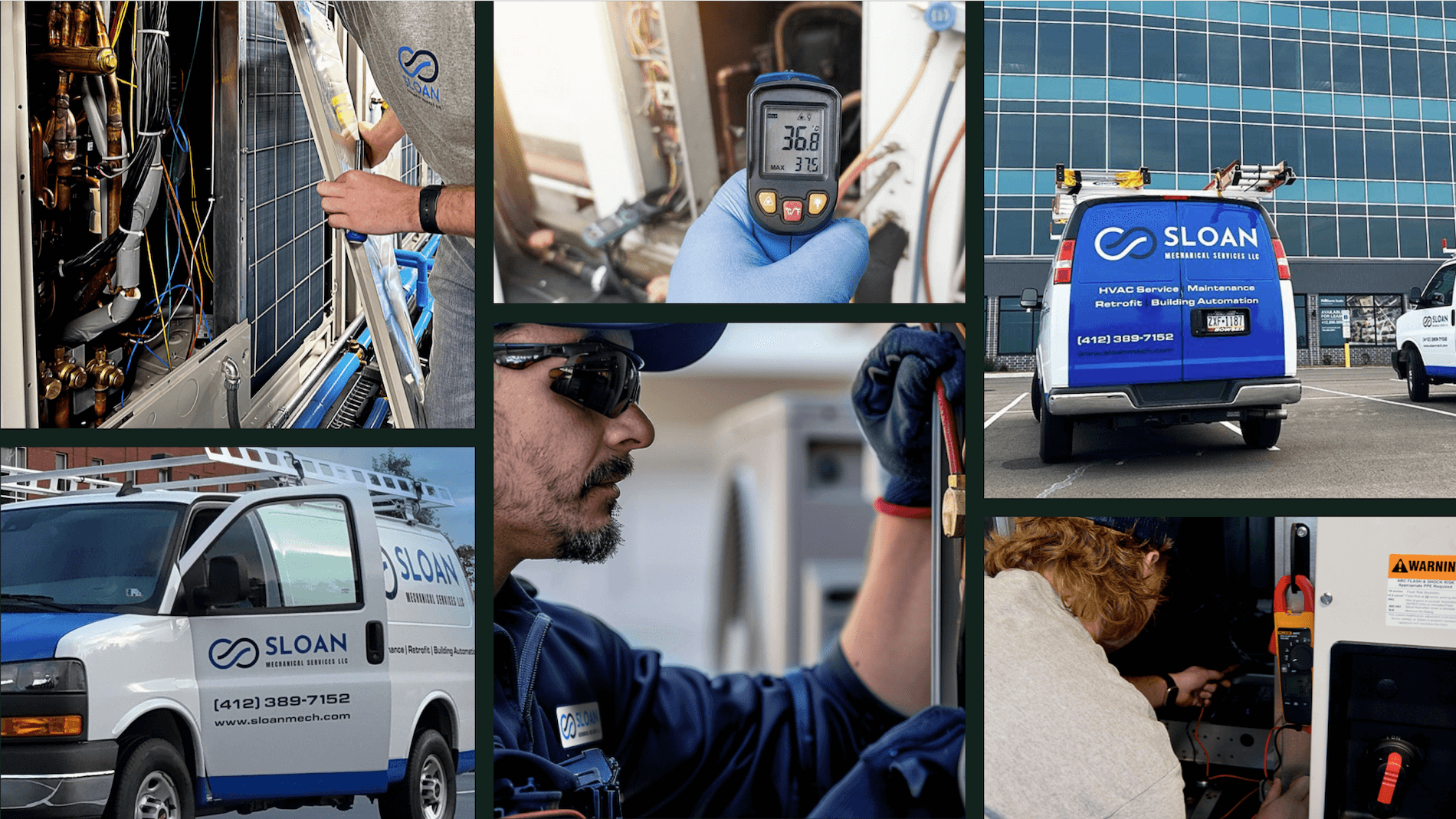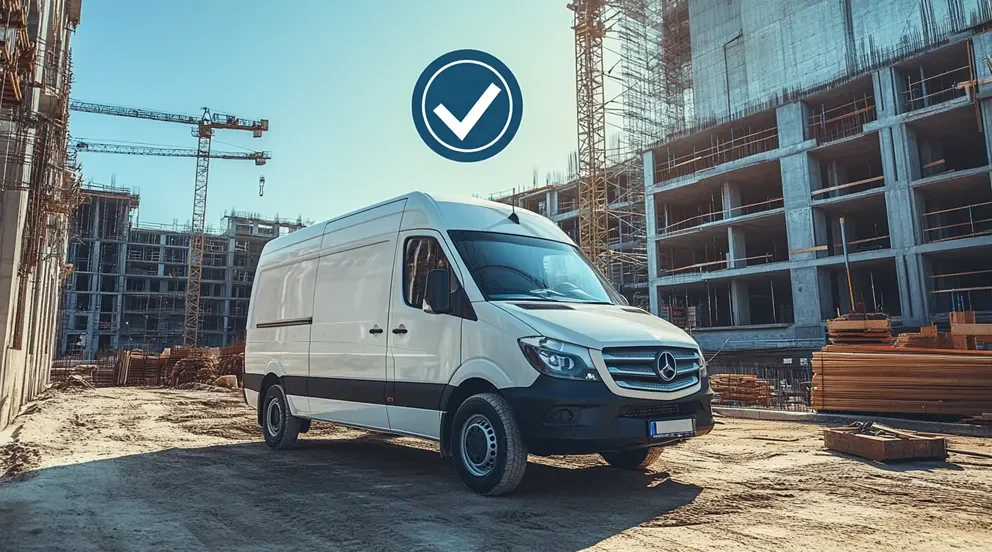Keeping crews, machines, and jobs aligned takes a clean system. Equipment dispatch software gives your team one place to assign operators, reserve assets, track hours, and keep customers in the loop. Run cranes, excavators, generators, or bucket trucks? Heavy equipment fleet dispatch software ties each unit to certified techs and active work orders.
It also connects with field service management tools—scheduling, time tracking, inventory, and telematics—so the office, the yard, and the field stay in sync.
In this guide, you’ll find:
- Choosing an equipment dispatch software for your needs
- 6 key features to look for in an equipment dispatching software
- Best equipment dispatch software for commercial
- Best equipment dispatch software for residential
- Best equipment dispatch software for contractors
- Other notable heavy equipment dispatching solutions
- 5 benefits of using dispatch software for equipment services
- 4 important equipment dispatch software FAQs answered
Let’s kick things off by focusing on selection. Once you know what your team needs day to day, comparing platforms gets a whole lot easier.
Choosing an equipment dispatch software for your needs
When evaluating equipment dispatch software, start with how your operation runs—job mix, asset types, compliance, and pace. Aim for a platform that coordinates people and machines, keeps schedules tight, and keeps communication clear. Use these questions to size up options:
- Workload and urgency — How many service calls, rentals, moves, or project shifts hit each day, and can the system handle spikes and last-minute changes?
- Fleet makeup and capacity — Which equipment classes and attachments need dispatching, and can you reserve by unit or class while honoring load limits and transport windows?
- Operator qualifications and safety — Does dispatch match licenses and certs to every job, block expired credentials, and require digital inspections and permits?
- Location, telematics, and maintenance — Will it pull GPS, engine hours, geofences, and fuel data to find the nearest suitable unit and auto-trigger PMs or holds from meter readings?
- Communication and systems — Are ETAs and status texts automatic, and does it connect with field service management, ERP, inventory, and accounting for clean handoffs?
- Features — Which software features matter to your crew day to day—drag-and-drop board, asset reservations, map view, nearest-unit suggestions, mobile time tracking, and clear reports?
With these answers, your shortlist gets clear. Next up, six essentials to look for in equipment dispatching software—the capabilities that lift utilization, cut idle time, and keep crews moving.
Equipment dispatch software features
The best equipment dispatch software solves daily headaches across crews, assets, and jobs. Heavy equipment fleet dispatch software should connect operators, machines, and schedules while keeping data clean for payroll and billing. Below are six essentials that keep field work tight and profitable.
1. Real-time scheduling and dispatch
A clear board keeps jobs moving. With field service scheduling, dispatchers assign an operator, reserve the unit, attach required tooling, and push updates to mobile in seconds. For example, a crane swap pops up at 6 a.m.; the dispatcher drags the call onto the schedule, pairs the certified operator, and the site receives an instant ETA. Hours start the moment the crew accepts, so labor ties back to the job without extra steps.
2. Mobile hour capture for labor and equipment
Crews need fast, accurate time. A contractor time tracking app lets operators clock in on arrival, tag labor to cost codes, and record engine hours for the assigned unit. Say a trenching crew finishes a shift at a campus build—each tech submits hours on the phone, the operator logs meter time for the excavator, and approvals hit the office before the team leaves the site.
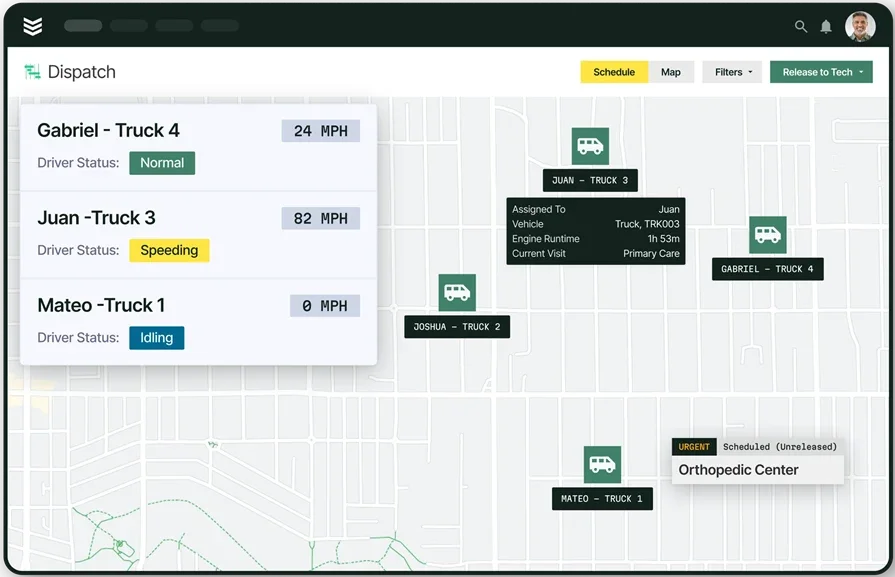
Equipment dispatch made simple
Assign operators, capture hours, and reroute units with live GPS and clean approvals.
3. GPS, engine hours, and geofences
Location data keeps decisions sharp. Fleet tracking pulls GPS, engine hours, fuel, and geofence events into dispatch. During a rain delay, the coordinator checks which skid steer sits nearest the dry site, confirms hour readings for maintenance, and reassigns the unit with a single move. Travel, idle, and on-site time feed straight into the job record.
4. Cost codes, approvals, and payroll-ready timesheets
Clean data drives job cost control. With analytics & reporting tied to time entries, supervisors approve hours by wage class and equipment type, then push payroll totals without rekeying. For instance, a foreman reviews one screen showing labor, overtime, and tracked engine hours; the contractor timesheet app view shows who’s missing entries and locks submissions after approval.
5. From approved time to cash
Fast billing hinges on accurate time. Invoicing pulls approved labor and equipment hours into line items, while payments captures deposits or card-on-file for T&M work. On a generator rental with emergency setup, the office bills the same day using approved timesheets; the customer pays on the spot, and AR clears without chasing.
6. Customer records and recurring PMs
Strong relationships cut downtime. A service CRM centralizes sites, contacts, and asset history, while service agreements schedule recurring PMs from meter or calendar rules. During peak season, dispatch auto-books quarterly inspections for lifts across a logistics campus, pairing each unit with the operator certified for that model.
Expert Tip
When weather flips the plan, a tight playbook wins. This quick primer on fleet dispatch software shows practical ways to stage units, reroute fast, and keep jobs moving.
Other valuable features for equipment service companies
You’ve got scheduling, time, and GPS covered. Round it out with extras that tighten day-to-day work in construction equipment dispatch software and keep crews, operators, and assets moving without hiccups.
- Offline-first mobile workflows — capture hours, photos, and forms without signal, then sync when service returns
- Role-based permissions and audit trails — control who sees what, and keep a clean history for compliance checks
- Attachment pairing — lock buckets, forks, or counterweights to base units so dispatch never splits required gear
- Transport and haul coordination — plan lowboys, delivery windows, and crane setup crews from the same board
- Inventory and parts staging — reserve parts against work orders so teams leave the yard ready
- Utilization and capacity views — spot idle assets and overbooked operators early with clear dashboards
With these pieces in place, your stack covers the daily grind from yard to job site. Next up, we’ll look at top picks for commercial teams and how they handle complex workloads.
Best equipment dispatch software for commercial: BuildOps
BuildOps brings a fast dispatch board, operator-to-asset matching, and customer hierarchy tools into one hub–built for complex commercial operations. Crews get live updates on mobile while the office pairs certified operators with cranes, lifts, generators, or trucks in seconds—exactly what heavy equipment fleet dispatch software should do. With BuildOps, teams keep schedules tight, utilization high, and handoffs clean across divisions.
How Pricing Works: BuildOps hosts weekly demos and offers tailored plans based on team size and required modules. A short discovery call helps align features with your workload.
Features Beyond Dispatching:
- Customizable invoicing and billing — automate payment processing and generate detailed invoices suited to your pricing model
- Integrated reporting — track job performance, technician productivity, and operational KPIs with clear dashboards
- Asset management — manage customer assets and internal equipment with service history and upcoming maintenance
What Sets It Apart for Commercial: Built to handle the pace and complexity of commercial work—live dispatch, scheduling, billing, and reporting operate on the same platform for clean execution at scale.
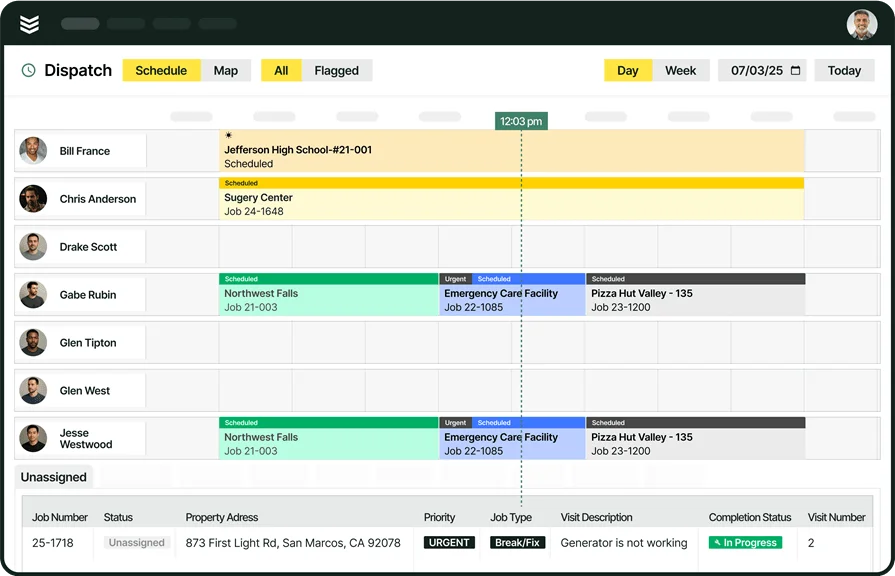
Plan your equipment dispatch with BuildOps
See how one board coordinates operators, assets, and schedules across your crews
Best equipment dispatch software for residential: Kickserv
Image Source: Kickserv
Kickserv aims at home service teams that want simplicity and quick setup. It integrates with common tools like QuickBooks and Mailchimp, and its clean dispatch board helps small crews keep appointments on track. However, advanced capabilities sit behind higher-priced plans, which can limit value for budget-sensitive teams.
How Pricing Works: Kickserv offers tiered pricing with core features at the entry level and expanded capabilities at premium levels.
Features Beyond Dispatching:
- Customer portal that lets homeowners review job history, approve estimates, and handle payments
- Basic reporting for job tracking and crew performance
What Sets It Apart for Residential: A straightforward interface and familiar integrations suit small residential teams handling routine service calls.
Best equipment dispatch software for general contractors: FieldEdge
Image Source: FieldEdge
FieldEdge serves contractors running dispatch across several trades, offering a central hub for scheduling, customer data, and billing. It includes solid tools for multi-service operations and can cover a wide range of workflows. That said, setup and training can feel heavy for smaller teams that prefer a lighter footprint.
How Pricing Works: FieldEdge’s pricing varies by user count, with options that scale for larger organizations.
Features Beyond Dispatching:
- Inventory tracking to keep parts aligned with scheduled work
- Marketing and follow-up tools to support service growth
What Sets It Apart for General Contractors: Broad feature coverage and detailed reporting help organizations that coordinate many services from a single platform.
Other notable heavy equipment dispatching solutions
Choosing heavy equipment fleet dispatch software depends on fleet size, telematics needs, and how your office handles jobs and billing. Some tools lean toward tracking and safety, while others favor light service work. Here are three options worth a look and what sets each apart.
Samsara
Image Source: Samsara
Samsara focuses on fleet operations and dispatch, tying GPS, dash cams, and driver data into one map for quick decisions. It fits teams that run many vehicles and want tight control over routes, fuel, and safety programs. However, its fleet-first approach may feel thin for contractors needing deep office workflows like complex job costing or advanced billing in construction equipment dispatch software.
How Pricing Works: Subscription model; hardware such as trackers and cameras adds to total cost.
Features Beyond Dispatching:
- Fleet monitoring and vehicle diagnostics
- Route optimization with real-time updates
- Driver coaching and safety alerts
What Sets It Apart: Strong telematics and compliance features for mobile fleets that live on the road.
Jobber
Image Source: Jobber
Jobber serves small and midsize service teams with an easy dispatcher, quick quoting, and simple invoicing. Setup runs fast and the mobile app keeps crews organized on routine visits. That said, teams managing large equipment, attachments, and operator certifications may find limits when dispatching complex work.
How Pricing Works: Tiered plans start at entry level and scale for premium features.
Features Beyond Dispatching:
- Client management and work history
- Templates for quotes and invoices
What Sets It Apart: A clean interface that helps small crews get jobs on the calendar without friction.
Housecall Pro
Image Source: Housecall Pro
Housecall Pro targets residential service providers with online booking, automated reminders, and fast job updates. Homeowners can schedule appointments and receive status texts without calling the office. For heavy equipment work, though, the feature set can feel light on asset controls and operator-to-equipment matching.
How Pricing Works: Affordable plans with optional add-ons for reviews and marketing.
Features Beyond Dispatching:
- Online customer booking and reminders
- Simple customer communications
What Sets It Apart: A homeowner-friendly experience that reduces phone time for residential teams.
5 benefits of using dispatch software for equipment services
Running a busy yard takes tight coordination. Equipment dispatch software connects operators, assets, and job details so every shift starts clean and ends with accurate data. Here’s how it helps field teams across trades.
1. Faster scheduling and assignment
Auto-matching operators, unit class, and job requirements cut back-and-forth and get work moving fast. With high-urgency calls, heavy equipment fleet dispatch software lets coordinators slot a certified operator, reserve attachments, and push updates in seconds. Teams that follow standard work order dispatch flows keep tickets consistent from intake to closeout, which helps crews arrive prepared.
2. Lower drive time with smarter routing
Fuel, hours, and vehicle wear stay in check when dispatchers can see nearest units and live traffic. A field service dispatch app keeps the board current for office and field, so reroutes land instantly and crews stay on productive time. The result: fewer empty miles and tighter windows for crane setups and haul-outs.
3. Clearer customer updates and faster approvals
Status texts, ETAs, and job notes replace phone tag and speed up go-aheads for extra work. Pairing dispatch with a contractor CRM centralizes contacts, site rules, and asset history, so the next visit lands with the proper operator and attachments already listed. Customers see precise ETAs and signed approvals inside the job record, which reduces callbacks.
4. Fewer disputes and tighter paperwork
Standard checklists and consistent data entry lead to clean tickets, accurate times, and easy audits. Teams that adopt field service dispatching see time entries align with equipment meters, sign-offs land faster, and audits go smoothly—especially in construction equipment dispatch software environments. That consistency shortens closeout and keeps billing disputes to a minimum.
Deep Dive
Consistent tickets, time logs, and signatures cut billing disputes. For a step-by-step playbook that aligns time entries with meters, standardizes checklists, and creates audit-ready closeouts, see our comprehensive guide to field service dispatching.
It covers intake-to-invoice flows used by equipment service contractors, including change approvals, photo proof, and record retention.
5. Higher utilization and better capacity planning
Hour capture tied to assets reveals idle time and helps plan PMs without sacrificing uptime. Dispatchers see which units earn, which sit, and where to shift crews next week to hit targets. Planners can forecast labor and haul capacity by unit class to prevent bottlenecks.
4 important equipment dispatch software FAQs answered
You’ve seen how the features and benefits play out in the field. Here are the focused answers pros ask when they evaluate, run, and improve equipment dispatch across busy fleets.
1. What is equipment dispatch software?
Equipment dispatch software coordinates operators, assets, and jobs in one system. It matches certified tech to units, reserves attachments, tracks labor hours, pushes mobile updates, and feeds payroll, invoicing, and maintenance. Many platforms also include GPS for location, fuel, and engine data.
2. How is equipment dispatching different from scheduling?
Scheduling builds the plan with dates, windows, and resource availability. Dispatching executes the plan in real time by pairing certified operators to specific units and attachments, coordinating transport, enforcing safety or maintenance holds, reacting to site changes, and closing with accurate hours and meters.
3. What does an equipment dispatcher oversee day to day?
Dispatchers balance capacity by unit class, assign certified operators, reserve attachments, and book lowboys. They monitor GPS and engine hours, approve time, clear safety or maintenance holds, and manage ETAs and site rules so heavy equipment fleet dispatch software delivers clean utilization without compliance risk.
4. What are the best practices for equipment dispatch?
Pros use a tight playbook that drives fast assignments, safe moves, and clean data across crews and assets. The aim is predictable execution that also feeds billing and maintenance without rework. Use this checklist to pressure test your process.
- Standardize work order types and status steps across divisions
- Enforce license, certification, and union rule checks before assignment
- Pair attachments and special tooling to base units at the reservation level
- Use geofences and GPS to trigger arrival, idle, and departure events
- Gate dispatch with maintenance holds based on meter or fault codes
- Capture labor and engine hours in a contractor time tracking app at the job level
- Require supervisor approvals through a contractor timesheet app before payroll export
- Store site rules, permits, lift plans, and photos inside the job record
- Route by nearest suitable unit, considering capacity, road limits, and site access
- Review weekly metrics such as utilization by class, on-time starts, re-dispatch counts, and billable variance across construction equipment dispatch software reports
From the selection checklist to core features, vendor options, benefits, and best practices, the path is clear. Equipment dispatch software keeps operators, assets, and jobs in lockstep so crews spend less time juggling calls and more time producing.
When your fleet spans cranes, lifts, pumps, or generators, heavy equipment fleet dispatch software becomes the control room for scheduling, time capture, routing, compliance, and billing.
If your team needs a single system to handle commercial field service at scale, BuildOps brings dispatch, fleet, maintenance, invoicing, and reporting together without extra spreadsheets.

Unify equipment dispatch and field service
See how BuildOps ties operators, assets, schedules, and billing into one clean workflow
